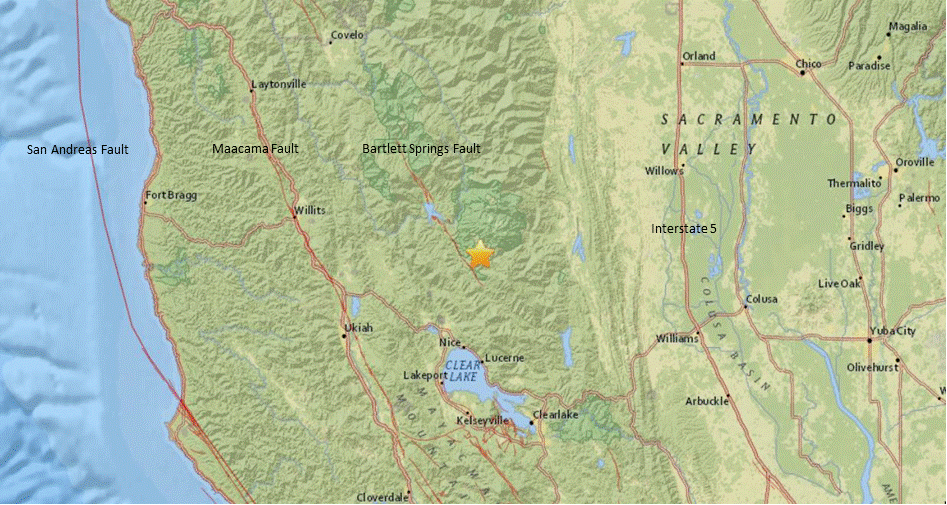Seismo Blog
A Stepping Stone to the Pacific Plate
Categories: Northern California | Earthquake Faults and Faulting | Bartlett Springs
August 11, 2016
California is full of faults. Although this sentence is a cheap pun amongst seismologists, it was the first thing that came into the blogger's mind when he heard about the surprising temblor in Lake County on Tuesday night (August 9th) around 8 pm. With a magnitude of 5.1, the quake was felt from Point Arena on the coast all the way east to Chico and Oroville in the Sierra foothills. It was located in a remote area of the southern Mendocino National Forest about 25 miles northeast of Ukiah and 10 miles south of Lake Pillsbury at a depth of 8 miles.

It occurred along a fault that most Californians will have never heard of: the Bartlett Springs Fault. This faultline runs for about 100 miles through Lake County, from the Round Valley Indian Reservation in the North through the waters of Lake Pillsbury until it ends in the south, when it crosses Bartlett Springs Road east of Clear Lake. This road and the nearby spring gave the fault its name. Much of the fault runs through the new "Berryessa Snow Mountain National Monument," which President Obama created by proclamation about a year ago.
Even though the Bartlett Springs Fault was identified by geologists decades ago, it has hardly been investigated in detail. One reason for the lack of research activity is that rather few quakes happen along this fault when compared to the seismicity along other faults in Northern California like the San Andreas or Calaveras Faults. Tuesday's quake was the strongest temblor along this fault for more than 50 years. The other reason is that the population density along the Bartlett Springs fault is very low - keep in mind that all of Lake County has a population of less than 70,000 people. Both points together make the seismic risk, which is the potential for damage and losses due to an earthquake, along the Bartlett Springs Fault considerably lower than here in the Bay Area.
Nevertheless, as Tuesday's temblor showed, this fault is active. In addition, Jim Lienkaemper, the geologist with the US Geological Survey in Menlo Park who probably did more seismic investigations along the Bartlett Springs Fault than anybody else, found creep along some sections of the fault. He found that the two sides of the fault move past each other at a rate of about a quarter of an inch per year.
The Bartlett Springs Fault is part of the wide zone of earthquake faults generated by the boundary between the Pacific and the North American plates, which governs the geology of most of California. Although such boundaries are drawn on maps as single, narrow lines, they are in fact broad zones, which can be dozens of miles wide. Look at the Bay Area itself. Here the plate boundary is split into several faults, which run parallel to each other. The westernmost extension of this zone is the San Gregorio Fault, which lies mostly offshore. It is followed to the east by the San Andreas, the Hayward, the Calaveras, and finally the Greenville Fault, which is located east of Livermore. The distance between the San Gregorio Fault and the Greenville Fault is more than 50 miles - which is in fact the width of the plate boundary here in our area.
The situation is similar in Lake County up north. Coming from the east, the Bartlett Springs Fault is the first stepping stone from the North American to the Pacific Plate. It is followed in the west by the Maacama Fault, which essentially runs along Highway 101 between an area northeast of Santa Rosa and Laytonville. Finally, the western limit of the boundary zone is defined by the San Andreas Fault itself. The San Andreas Fault picks up about half of the movement between the plates, which is estimated to be about two inches per year. The Maacama Fault creeps by at about half an inch per year, and the Bartlett Fault moves, as mentioned above, by about a quarter inch. (hra124)
BSL Blogging Team: Who we are
Recent Posts
-
: Alerts for the Whole West Coast
-
: Destruction in the Eastern Aegean Sea
-
: An Explosion in Beirut heard all over the Middle East
View Posts By Location
Categories
- Alaska (3)
- Bay Area (24)
- Buildings (3)
- Calaveras (4)
- California (13)
- California ShakeOut (3)
- Central California (4)
- Chile (4)
- Earthquake Early Warning (10)
- Earthquake Faults and Faulting (44)
- Earthquake Science (3)
- Haiti (3)
- Hayward (12)
- Indonesia (4)
- Induced Seismicity (3)
- Instrumentation (18)
- Italy (6)
- Japan (7)
- MOBB (3)
- Mendocino Triple Junction (5)
- Mexico (7)
- Nepal (3)
- North Korea (5)
- Nuclear Test (5)
- Ocean Bottom Seismometer (3)
- Oklahoma (4)
- Plate Tectonics (18)
- Preparedness, Risks, and Hazards (16)
- Salton Sea (3)
- San Andreas Fault (14)
- Seismic Waves (13)
- Seismograms (4)
- ShakeAlert (3)
- Southern California (5)
- Surface Waves (3)
- Today in Earthquake History (20)
- Volcanoes (4)
- subduction (3)